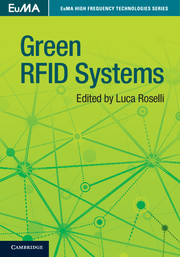Book contents
- Frontmatter
- Contents
- List of contributors
- Introduction
- 1 Context analysis
- 2 RFID background
- 3 Energy scavenging and storage for RFID systems
- 4 Technologies for RFID sensors and sensor tags
- 5 Unconventional RFID systems
- 6 Integrating tiny RFID- and NFC-based sensors with the Internet
- 7 Materials for substrates
- 8 Organic conductors and semiconductors: recent achievements and modeling
- 9 RFID enabling new solutions
- 10 Energy-efficient off-body communication using textile antennas
- Index
- References
1 - Context analysis
Published online by Cambridge University Press: 05 October 2014
- Frontmatter
- Contents
- List of contributors
- Introduction
- 1 Context analysis
- 2 RFID background
- 3 Energy scavenging and storage for RFID systems
- 4 Technologies for RFID sensors and sensor tags
- 5 Unconventional RFID systems
- 6 Integrating tiny RFID- and NFC-based sensors with the Internet
- 7 Materials for substrates
- 8 Organic conductors and semiconductors: recent achievements and modeling
- 9 RFID enabling new solutions
- 10 Energy-efficient off-body communication using textile antennas
- Index
- References
Summary
Introduction
This chapter addresses the present challenges facing radio frequency identification (RFID) systems and aims to highlight the perspective and potential of this technology which, due to attractive properties such as low power, low cost, and ability to integrate sensing functionality, is enjoying widespread application and a growing market potential. The simplicity and minimalist approach in the design of RFID tag circuits has led to their widespread utilization in supply chain and logistics applications. IDTechEX reported that the total RFID hardware market value was 5.56 billion US$ in 2009 and is expected to increase above 25 billion US$ by 2019 [1]. In 2005 the large volume electronic product code (EPC) tag cost was US$0.13 [2], while the recent volume pricing of UHF RFID transponders is approximately US$0.10 (for example [3]). A further price reduction below US$0.05 is desired in order to achieve additional market penetration [4]. The World Wide Research Forum (WWRF) estimates that 7 trillion wireless devices will be serving 7 billion people by 2017 [5]. RFID systems with sensing functionality are a fundamental technology for realizing a network of interconnected devices, which represents the vision of ubiquitous sensing and communication.
This chapter aims to set out the background to the exciting technological advances and properties that RFID systems are required to accomplish, demonstrating how RFID technology is capable of providing a solution towards ubiquitous sensing smart environments. It begins with a brief historical perspective, showing the major milestones in the evolution and commercialization of RFID technology. The remaining paragraphs highlight existing performance challenges and problems, from a brief description of networking and security issues to more detailed circuit, system, material, and computer aided design (CAD) topics, which will be addressed in more detail in the rest of this book.
Information
- Type
- Chapter
- Information
- Green RFID Systems , pp. 1 - 16Publisher: Cambridge University PressPrint publication year: 2014
